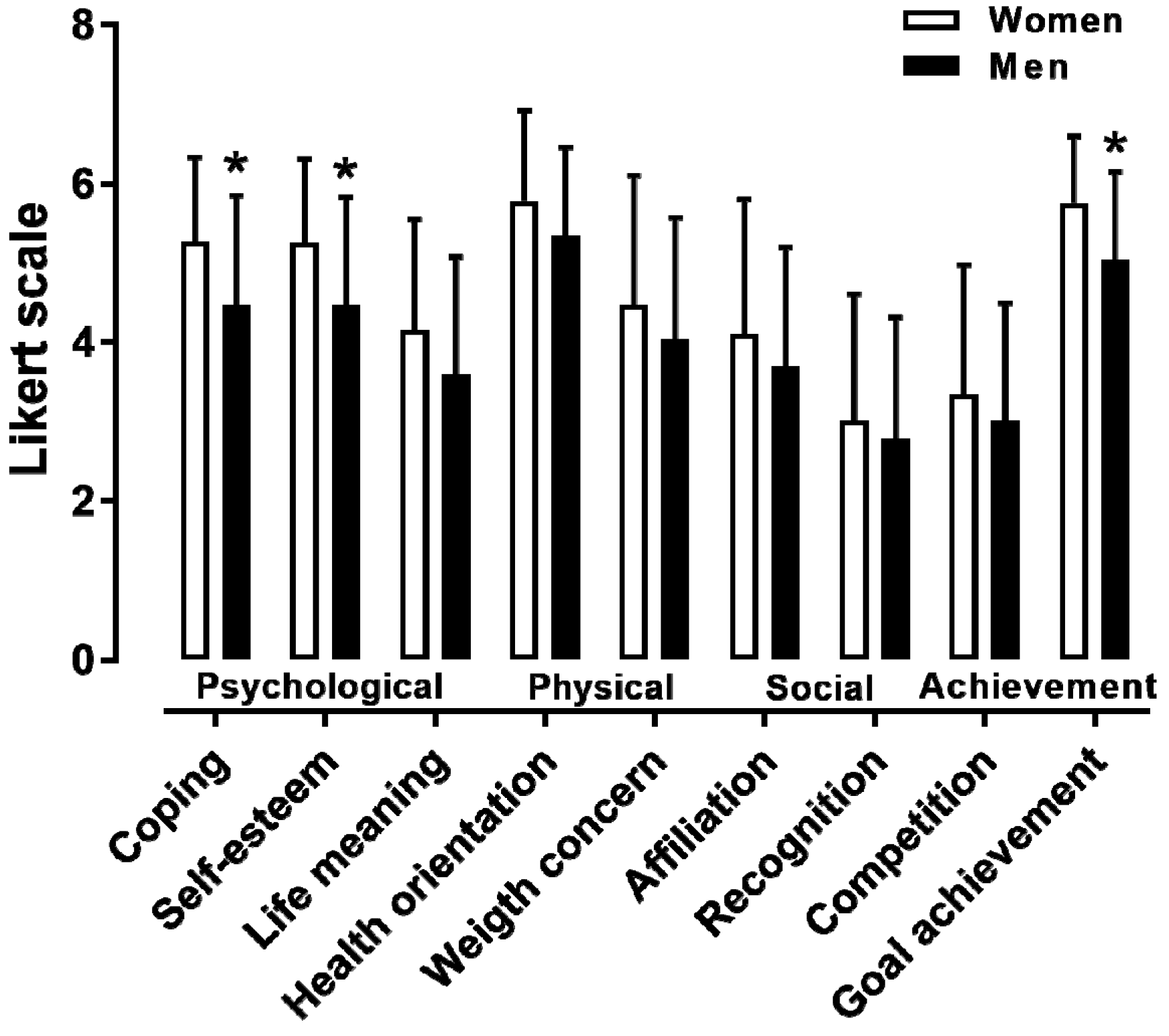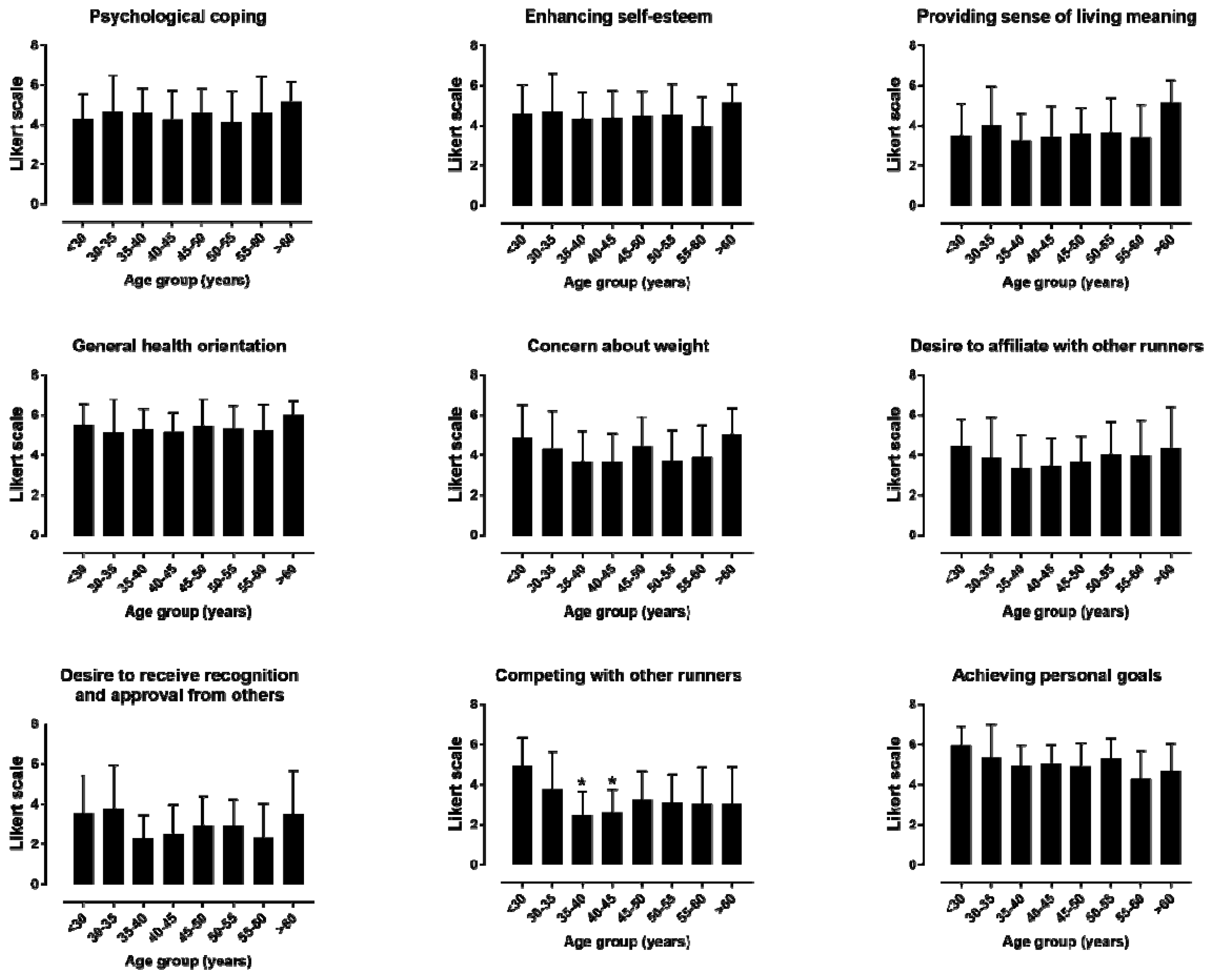Motivation in the Athens Classic Marathon: The Role of Sex, Age, and Performance Level in Greek Recreational Marathon Runners
Abstract
:1. Introduction
2. Materials and Methods
2.1. Subjects
2.2. Design
2.3. Experimental Procedures
2.4. Statistical Analysis
3. Results
4. Discussion
Limitations, Strength and Practical Applications
5. Conclusions
Author Contributions
Funding
Acknowledgments
Conflicts of Interest
References
- Jokl, P.; Sethi, P.M.; Cooper, A.J. Master’s performance in the New York City Marathon 1983–1999. Br. J. Sports Med. 2004, 38, 408–412. [Google Scholar] [CrossRef]
- Nikolaidis, P.T.; Rosemann, T.; Knechtle, B. Age-Predicted Maximal Heart Rate in Recreational Marathon Runners: A Cross-Sectional Study on Fox’s and Tanaka’s Equations. Front. Physiol. 2018, 9, 226. [Google Scholar] [CrossRef] [PubMed]
- Doppelmayr, M.; Molkenthin, A. Motivation of participants in adventure ultramarathons compared to other foot races. Biol. Sport 2004, 21, 319–323. [Google Scholar]
- Van Middelkoop, M.; Kolkman, J.; Van Ochten, J.; Bierma-Zeinstra, S.M.; Koes, B. Prevalence and incidence of lower extremity injuries in male marathon runners. Scand. J. Med. Sci. Sports 2008, 18, 140–144. [Google Scholar] [CrossRef]
- Ruiz-Juan, F.; Sancho, Y.A.Z. Analysis of motivation amongst spanish marathon runners. Revista Latinoamericana de Psicologia 2014, 46, 1–11. [Google Scholar] [CrossRef]
- Zarauz, A.; Ruiz-Juan, F.; Flóres-Allende, G. Predictive models of motivation in route runners based on their training habits. Revista Iberoamericana de Psicologia del Ejercicio y el Deporte 2016, 11, 185–192. [Google Scholar]
- Sancho, A.Z.; Ruiz-Juan, F. Super-adherence of marathoners: Predictor variables and gender differences. Universitas Psychologica 2012, 11, 895–907. [Google Scholar] [CrossRef]
- Ogles, B.M.; Masters, K.S. Older vs. Younger adult male marathon runners: Participative motives and training habits. J. Sport Behav. 2000, 23, 130–143. [Google Scholar]
- Nikolaidis, P.T.; Rosemann, T.; Knechtle, B. Sex Differences in the Age of Peak Marathon Race Time. Chin. J. Physiol. 2018, 61, 85–91. [Google Scholar] [CrossRef] [PubMed]
- Kim, S.; Liu, J.D.; Love, A. Event Prestige as a Mediator between Sport Involvement and Intent to Continue Participation. Percept. Mot. Ski. 2015, 121, 371–389. [Google Scholar] [CrossRef]
- Masters, K.; Ogles, B. An investigation of the different motivations of marathon runners with varying degrees of experience. J. Sport Behav. 1995, 18, 69–79. [Google Scholar]
- Newcomer, B.D. Motives of marathon runners in training: Investigating the differences between gender, experience level and age. Diss. Abstr. Int. Sect. B Sci. Eng. 2008, 69, 7125. [Google Scholar]
- Nikolaidis, P.T.; Alvero-Cruz, J.R.; Villiger, E.; Rosemann, T.; Knechtle, B. The Age-Related Performance Decline in Marathon Running: The Paradigm of the Berlin Marathon. Int. J. Environ. Res. Public Health 2019, 16, 2022. [Google Scholar] [CrossRef] [PubMed]
- The Big Record of Participants in the Athens Marathon was Confirmed. Available online: http://www.runningnews.gr/item.php?id=34019 (accessed on 8 July 2019).
- Nikolaidis, P.T.; Knechtle, B. Force-velocity characteristics and maximal anaerobic power in male recreational marathon runners. Res. Sports Med. 2019. [Google Scholar] [CrossRef] [PubMed]
- Nikolaidis, P.T.; Rosemann, T.; Knechtle, B. Force-Velocity Characteristics, Muscle Strength, and Flexibility in Female Recreational Marathon Runners. Front. Physiol. 2018, 9, 1536. [Google Scholar] [CrossRef] [PubMed]
- Masters, K.S.; Ogles, B.M.; Jolton, J.A. The Development of an Instrument to Measure Motivation for Marathon Running: The Motivations of Marathoners Scales (MOMS). Res. Q. Exerc. Sport 1993, 64, 134–143. [Google Scholar] [CrossRef] [PubMed]
- Zach, S.; Xia, Y.; Zeev, A.; Arnon, M.; Choresh, N.; Tenenbaum, G. Motivation dimensions for running a marathon: A new model emerging from the motivation of marathon scale (moms). J. Sport Health Sci. 2017, 6, 302–310. [Google Scholar] [CrossRef]
- Hammer, C.; Podlog, L. Motivation and marathon running. In Marathon Running: Physiology, Psychology, Nutrition and Training Aspects; Zinner, C., Sperlich, B., Eds.; Springer: Basel, Switzerland, 2016; pp. 107–124. [Google Scholar] [CrossRef]
- Grogan, R. Run, Pheidippides, Run! The story of the Battle of Marathon. Br. J. Sports Med. 1981, 15, 186–189. [Google Scholar] [CrossRef]
- Beckmann, J.; Kossak, T. Motivation and Volition in Sports. In Motivation and Action; Heckhausen, J., Heckhausen, H., Eds.; Springer: Basel, Switzerland, 2018; pp. 853–889. [Google Scholar] [CrossRef]
- Krouse, R.Z.; Ransdell, L.B.; Lucas, S.M.E.; Pritchard, M. Motivation, Goal Orientation, Coaching, and Training Habits of Women Ultrarunners. J. Strength Cond. Res. 2011, 25, 1. [Google Scholar] [CrossRef]
- Deaner, R.O.; Lowen, A.; Rogers, W.; Saksa, E.; Badcock, N. Does the sex difference in competitiveness decrease in selective sub-populations? A test with intercollegiate distance runners. PeerJ 2015, 3, e884. [Google Scholar] [CrossRef]
- Ferrer, D.A.; Baumann, C.W.; Brandenberger, K.J.; Ellis, R.; Otis, J.S. Physical motivation influences race performance over a 24-hour ultra-marathon. Int. J. Sport Stud. 2015, 5, 1162–1169. [Google Scholar]
- Šmela, P.; Pačesová, P.; Kraček, S.; Hájovský, D. Performance Motivation of Elite Athletes, Recreational Athletes and Non-Athletes. Acta Fac. Educ. Phys. Univ. Comen. 2017, 57, 125–133. [Google Scholar] [CrossRef] [Green Version]
- Roebuck, G.S.; Fitzgerald, P.B.; Urquhart, D.M.; Ng, S.K.; Cicuttini, F.M.; FitzGibbon, B.M. The psychology of ultra-marathon runners: A systematic review. Psychol. Sport Exerc. 2018, 37, 43–58. [Google Scholar] [CrossRef]
- Malchrowicz-Mośko, E.; Poczta, J. Running as a Form of Therapy Socio-Psychological Functions of Mass Running Events for Men and Women. Int. J. Environ. Res. Public Health 2018, 15, 2262. [Google Scholar] [CrossRef] [PubMed]




| Specific Theme | Mean ± SD | Range | Cronbach’s Alpha |
|---|---|---|---|
| Psychological | |||
| Psychological coping | 4.62 ± 1.36 | 1.00–6.89 | 0.904 |
| Self-esteem | 4.62 ± 1.34 | 1.13–7.00 | 0.879 |
| Life meaning | 3.69 ± 1.49 | 1.00–6.86 | 0.881 |
| Physical | |||
| General health orientation | 5.43 ± 1.13 | 1.00–7.00 | 0.847 |
| Weight concern | 4.12 ± 1.56 | 1.00–7.00 | 0.843 |
| Social | |||
| Affiliation | 3.78 ± 1.54 | 1.00–7.00 | 0.901 |
| Recognition | 2.83 ± 1.53 | 1.00–6.83 | 0.930 |
| Achievement | |||
| Competition | 3.08 ± 1.51 | 1.00–7.00 | 0.858 |
| Personal goal achievement | 5.17 ± 1.10 | 1.67–7.00 | 0.797 |
| Specific Theme | Q1 (n = 32) | Q2 (n = 32) | Q3 (n = 35) | Q4 (n = 33) |
|---|---|---|---|---|
| Psychological | ||||
| Psychological coping | 4.43 ± 1.36 | 4.14 ± 1.52 | 4.83 ± 1.17 | 4.40 ± 1.41 |
| Self-esteem | 4.55 ± 1.39 | 4.23 ± 1.45 | 4.66 ± 1.26 | 4.36 ± 1.33 |
| Life meaning | 3.64 ± 1.47 | 3.38 ± 1.51 | 3.62 ± 1.46 | 3.70 ± 1.61 |
| Physical | ||||
| General health orientation | 5.28 ± 1.07 | 5.52 ± 0.87 | 5.34 ± 1.16 | 5.27 ± 1.35 |
| Weight concern | 3.83 ± 1.55 | 4.19 ± 1.72 | 4.07 ± 1.53 | 4.05 ± 1.44 |
| Social | ||||
| Affiliation | 3.67 ± 1.62 | 3.50 ± 1.58 | 3.81 ± 1.45 | 3.83 ± 1.42 |
| Recognition | 2.96 ± 1.62 | 2.75 ± 1.60 | 2.62 ± 1.30 | 2.79 ± 1.58 |
| Achievement | ||||
| Competition | 3.60 ± 1.59 | 3.13 ± 1.49 | 2.72 ± 1.15 | 2.74 ± 1.55 |
| Personal goal achievement | 5.40 ± 1.10 | 4.81 ± 1.19 | 5.25 ± 0.94 | 4.68 ± 1.12 |
© 2019 by the authors. Licensee MDPI, Basel, Switzerland. This article is an open access article distributed under the terms and conditions of the Creative Commons Attribution (CC BY) license (http://creativecommons.org/licenses/by/4.0/).
Share and Cite
Nikolaidis, P.T.; Chalabaev, A.; Rosemann, T.; Knechtle, B. Motivation in the Athens Classic Marathon: The Role of Sex, Age, and Performance Level in Greek Recreational Marathon Runners. Int. J. Environ. Res. Public Health 2019, 16, 2549. https://0-doi-org.brum.beds.ac.uk/10.3390/ijerph16142549
Nikolaidis PT, Chalabaev A, Rosemann T, Knechtle B. Motivation in the Athens Classic Marathon: The Role of Sex, Age, and Performance Level in Greek Recreational Marathon Runners. International Journal of Environmental Research and Public Health. 2019; 16(14):2549. https://0-doi-org.brum.beds.ac.uk/10.3390/ijerph16142549
Chicago/Turabian StyleNikolaidis, Pantelis T., Aïna Chalabaev, Thomas Rosemann, and Beat Knechtle. 2019. "Motivation in the Athens Classic Marathon: The Role of Sex, Age, and Performance Level in Greek Recreational Marathon Runners" International Journal of Environmental Research and Public Health 16, no. 14: 2549. https://0-doi-org.brum.beds.ac.uk/10.3390/ijerph16142549







